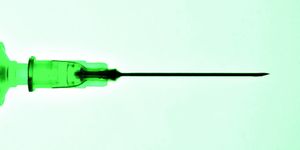HIV comes with high heart attack risk, but how high?
Current methods to predict the risk of heart attack and stroke vastly underestimate the risk in individuals with HIV, which is nearly double that of the general population, a new study shows.
“The actual risk of heart attack for people with HIV was roughly 50 percent higher than predicted by the risk calculator many physicians use for the general population,” says first author Matthew Feinstein, a cardiovascular disease fellow at Northwestern University Feinberg School of Medicine.
The study appears in JAMA Cardiology.
The higher risk for heart attack—about 1.5 to two times greater—exists even in people whose virus is undetectable in their blood because of antiretroviral drugs.
Accurately predicting an individual’s risk helps determine whether he or she should take medications such as statins to reduce the risk of heart attack or stroke.
“If you have a higher risk for heart attack or stroke, your ability to benefit from one of these drugs is greater and justifies the possible side effects of a medication,” Feinstein says.
New algorithm should help
A new predictive algorithm may need to be developed to determine the actual risk for heart attack and stroke in people with HIV, he says.
The study was conducted using a large, multi-center clinical cohort of HIV-infected individuals receiving care at one of five participating sites around the country. Researchers analyzed data from approximately 20,000 HIV-infected individuals. They compared predicted rates of heart attacks based on data from the general population to the actual rates of heart attacks observed in this cohort.
The primary driver of the higher risk is the HIV, scientists believe.
“There is chronic inflammation and viral replication even in people whose blood tests don’t show any sign of the virus in the blood,” Feinstein says. That’s because the virus still lurks in the body’s tissues, creating the inflammation that causes plaque buildup and can lead to a heart attack or a stroke.
Inflammation and other factors
Plaque buildup occurs 10 to 15 years earlier in HIV patients than in the uninfected population.
“It’s this inflammatory state that seems to drive this accelerated aging and these higher risks for heart disease, which are becoming more common in HIV patients as they live longer,” Feinstein says.
60% of gay and bi men unaware of anti-HIV pill
In addition to inflammation and other effects from the virus as factors in higher heart attack and stroke rates, senior study author Heidi Crane also points to higher rates of traditional risk factors like smoking.
“Despite these differences, we found that risk scores developed in the general population—while not as accurate as we would like—are still useful in assessing risk in HIV populations,” says Crane, associate professor of medicine at the University of Washington. “More research is needed to develop better ways to assess risk in HIV.”
More research needed
Feinstein and colleagues hope to collaborate with a large multi-center HIV cohort to develop a new algorithm. They attempted to do it with this study, but 20,000 patients weren’t enough for an accurate predictor. The current tool for predicting heart attack risk for the general population is based on more than 200,000 patients.
“Regardless of age, sex, or race, the risks are higher in people with HIV,” Feinstein says. Of HIV-infected groups, the study found the current predictor tool was least accurate in African American men and women and most effective for Caucasian men.
The new study builds on previous HIV-related heart disease research by Feinstein, published in November, 2016, which found individuals with HIV had more scarring in the heart muscle after heart attacks, indicating an impaired ability to heal their hearts. Reasons for this are unknown but are an area of active study for Feinstein and his colleagues.
A clinical trial is underway at Northwestern Medicine to evaluate how well common medications for heart disease prevention and treatment, such as statin medications, work to prevent heart disease in the HIV-infected population.
The National Institutes of Health and the American Heart Association supported the work.
Source: Northwestern University
Original Study DOI: 10.1001/jamacardio.2016.4494
This article was originally published on Futurity.org.









